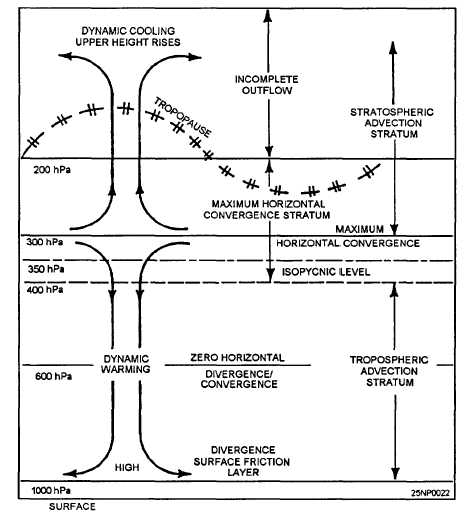levels, which may remain quite cold. A warming of
10°C per day at the 500-hPa level is not unusual. Such
a rate of warming is not entirely due to subsidence but
probably has a considerable contribution from warm
advection. However, continuity considerations suggest
that the convergence in the 400- to 200-hPa stratum
produces some sinking and adiabatic warming in the
lower troposphere. See figure 3-9.
Thus, in the building of anticyclones, there must be
a piling up of air at high levels due to horizontal velocity
convergence in the 400- to 200-hPa stratum, which
results in the stratospheric cooling observed with
developing anticyclones. Insufficient outflow at very
high levels results in an accumulation of mass. This is
roughly the mechanism thought to be responsible for the
development of high-pressure systems. The high-level
increase of mass overcompensates the low tropospheric
decrease of density, and the high-level effect thus
determines the sign of increase of pressure at the surface
when highs are intensifying. See figure 3-9.
The development of anticyclones appears to be just
the reverse of the deepening of cyclones. Outside of
cold source regions, and frequently in cold source
regions, high-level anticyclogenesis appears to be
associated with an accumulation of mass in the lower
stratosphere accompanied by ceding. In many cases
this stratospheric cooling maybe advective, but more
frequently the cooling appears to be clearly dynamic;
that is, due to the ascent of air resulting from horizontal
convergence in the upper troposphere.
Studies of successive soundings accompanying
anticyclogenesis outside cold source regions show
progressive warming throughout the troposphere. This
constitutes a negative contribution to anticyclogenesis.
In other words, outside of cold source regions, during
anticyclone development, the decrease in DENSITY in
the troposphere is overcompensated by an increase in
Figure 3-9.-Vertical circulation over developing high.
3-13



